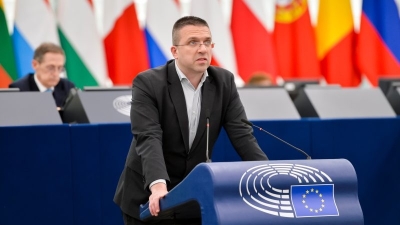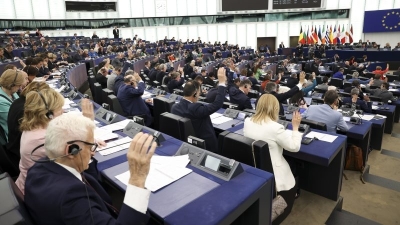IP, the invisible glue that connects creativity and competitiveness

Intellectual Property (IP) is sometimes described as the invisible glue or secret ingredient that breathes life into everything we create from music, film and poetry to industrial design and the standards that underly modern technologies. Invisible to the naked eye, it remains absolutely essential to the arts, business, health care and to bettering our overall quality of life.
Patrick McCutcheon is the Managing Director at IP Europe.
Behind IP is the simple idea that people who create unique forms of intangible property should have their creations protected s, be it by copyright, trademarks, industrial design protection and patents. These protect the inventors from plagiarists, copycats and other types of freeloaders, who would otherwise use or abuse their creative contributions without having to pay anything to the IP’s owner. More broadly, it also helps protect the emergence of these contributions in the first place: if there is no societal recognition for creativity, why bother to do it in the first place?
On this World Intellectual Property Day 2023, IP Europe, a coalition of R&D-intensive organisations whose inventions are protected by patents, applauds Europe’s role in the development of the open standards at the heart of modern electronic communications. However, on this day, we must also sound the alarm that these very same patents, and with them Europe’s leadership in technologies such as 5G, are under threat.
The theme of this year’s World Intellectual Property Day is Women and IP: Accelerating innovation and creativity, in recognition that women’s contributions to the arts, science and technology have been historically under-valued and under-recognised when compared to those of men. Women, including many unsung Europeans have been instrumental in the development of the essential-yet-invisible inventions on which many of today’s most widespread and useful technologies are based. To cite just a few examples:
- Dr. Nicole Grobert, a German-British materials scientist, developed several key technologies for the production of carbon nanomaterials, including graphene and carbon nanotubes. Her work has helped enable new applications in fields such as electronics, energy storage, and biomedical engineering and is protected by several patents. She is Chair of the European Commission’s Group of Chief Scientific Advisors.
- Hedy Lamarr, an Austrian-American inventor and later actress, co-invented a frequency-hopping spread spectrum technology during World War II to help prevent enemy interception of radio-controlled torpedoes. This technology laid the foundation for modern Bluetooth and Wi-Fi networks, and Lamarr is now recognized as a pioneer in wireless communications.
- Dr. Ursula Keller, a Swiss physicist, developed several key technologies incorporated into standard essential patents, including a mode-locked semiconductor laser that has been widely used in telecommunications and medical applications. For this, she was recognised in 2018 for the European Inventor of the Year Award.
In addition to putting a spotlight on the important contribution of European women to pathbreaking research and development, these examples highlight the role of patents, including standard essential patents, in contributing to the development of new technologies.

[Patrick McCutcheon [Chris Pulleyn at Morris & Chapman]
Patents are integral to many of the technologies incorporated in the open standards. Just compare the improved quality and performance of your current mobile phone with that of your first – working better than ever due to the seamless interoperability of handsets, transmission towers and network communications, combined with encryption and error correction, that work beneath the surface. It is these functionalities that are made possible by technical standards with which mobile handset manufacturers had little, if anything, to do. Without cellular connectivity, even the newest, most cutting-edge smartphone would be little more than a fancy calculator, camera, music player and game console.
Without open standards and a robust IP system, companies would keep more proprietary technologies to themselves, limiting interoperability with competing products. This creates significant barriers to entry and can concentrate market power in the hands of a few global gatekeepers—most of which are not based in Europe—and raise costs to consumers.
And yet policymakers in Europe are promoting the notion that many patents which are part of international technical standards should be subject to new rules and regulatory hurdles. These include a framework for aggregate royalty caps and other measures that would reduce transparency and predictablity.
At IP Europe, we support both open standards and a robust IP system. These allow both companies and individual inventors to invest and reinvest in innovation with an expectation of fair compensation for the technical inventions they contributed to the standards. These inventions are usually the result of many years of collaboration in standards development organisations.
Open standards benefit companies big and small equally, as anyone can make immediate use of patented technologies that they didn’t develop on the basis of fair, reasonable and non-discriminatory (FRAND) terms and conditions without fear of excessive fees. Since many of these technologies and standards are “made in Europe”, open standards benefit Europe as a whole by enhancing its strategic autonomy and technological sovereignty. They also benefit consumers world-wide.
On this World IP Day, we call on Europe to defend a patent system that has allowed European inventors and companies to play a leadership role in the tech sector, even as the manufacturing of many products has moved to other shores. While Europe may struggle to claw back manufacturing that it has lost, it must hold onto the technology and standards leadership it still has to maintain the well-functioning system of IP protection that has been an invisible but essential ingredient in Europe’s success.



